Archives: Projects
La Réunion Irrigation Project
Project Overview
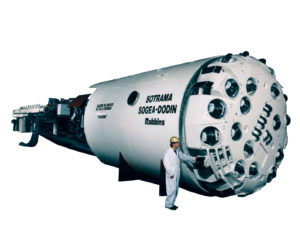 The La Réunion Irrigation Project is located in a French territory in the Indian Ocean. The project consists of a system of tunnels that irrigates sugar cane crops and provides water to the general population on the island’s west side. Underground tunnels transport water from three sources on the island’s water-rich east side to more arid western areas. Several organizations financed the project, including the European Community, the French Government, the Réunion Department and the Réunion Region.
The La Réunion Irrigation Project is located in a French territory in the Indian Ocean. The project consists of a system of tunnels that irrigates sugar cane crops and provides water to the general population on the island’s west side. Underground tunnels transport water from three sources on the island’s water-rich east side to more arid western areas. Several organizations financed the project, including the European Community, the French Government, the Réunion Department and the Réunion Region.
In 1990, French Contractor SOGEA awarded the TBM contract to Robbins. The company built a 4.3 m (14.1 ft) diameter Single Shield tunnel boring machine (TBM) for the boring of Tunnels I and II. Tunnel I carries the combined inflow of water from Tunnels II and III and river water from the Rivière de Galets. This water is then transported 8.6 km (5.3 mi) to a reservoir on the western side of the island. Tunnel II is a short 2.4 km (1.5 mi) tunnel that carries the water from Tunnel I via siphon under the Rivière de Galets.
Geology
Geology in all three La Réunion tunnels consisted mainly of olivine basalt. Faults in the region have created brecciated zones of blocky rock combined with mudstone and clay. Water inflows and alterations are typical of these zones.
TBM
Robbins designed the Single Shield TBM to meet the unique challenges of abrasive rock and water inflows in the two tunnels. The machine’s cutterhead featured five buckets and 29 recessed back-loading 17 inch (432mm) disc cutters mounted for safe changing from the rear.
Six 160 kW (214.5 hp) motors powered the cutterhead and generated over 1,297,547 N-m (960,177 lb-ft) of torque. The two-speed articulated cutterhead increased direction control and stability in blocky rock. Robbins also added a pumping system to the TBM and seals to the cutterhead and shield. These added features prepared the machine for boring through basalt with heavy water inflows.
The TBM’s ventilation system included a 900 mm (35.4 in) diameter fan, an air duct, an air conditioning unit and a cassette system control-mounted on the TBM back-up.
Tunnel Excavation
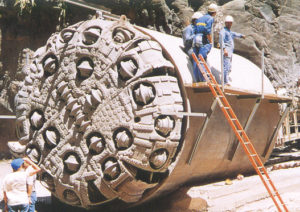 In Tunnel I, the TBM met its first challenge at the outset. The initial 500 m (1,640.4 ft) of the drive consisted of hard volcanic debris, water, and blocky rock. The TBM encountered two extensive zones of poor rock with maximum water inflows into the tunnel of approximately 45 liters (11.9 gallons) per second. The crew and Robbins field service engineers dealt with these problems with several on-site modifications. One of these modifications involved removal of the extendable cutter to allow installation of an extra bucket in the face. This extra bucket increased the number of openings and improved face cleaning operations, leading to more efficient tunnel boring.
In Tunnel I, the TBM met its first challenge at the outset. The initial 500 m (1,640.4 ft) of the drive consisted of hard volcanic debris, water, and blocky rock. The TBM encountered two extensive zones of poor rock with maximum water inflows into the tunnel of approximately 45 liters (11.9 gallons) per second. The crew and Robbins field service engineers dealt with these problems with several on-site modifications. One of these modifications involved removal of the extendable cutter to allow installation of an extra bucket in the face. This extra bucket increased the number of openings and improved face cleaning operations, leading to more efficient tunnel boring.
During boring, the wear on the cutter assembly hubs was severe due to the soft but highly abrasive olivine basalt. This problem was partially resolved by the tunnel crew who decided to hardface the hubs. Cutter ring wear varied from 300 hours of life for center cutters to 50 hours of life for gauge cutters in the most abrasive conditions.
Despite difficult geologic conditions, the TBM continued to make significant advances and finished on schedule. The machine advanced at an average rate of 4.46 m (14.6 ft) per hour. An average workweek consisted of five days in three shifts, totaling 1,989 machine hours.
The TBM achieved breakthrough in Tunnel I on September 17, 1992 and then underwent a routine rebuild and testing for Tunnel II. The machine began boring the second tunnel in 1993 and finished in six months.
Hong Kong Cable Tunnel
Project Overview
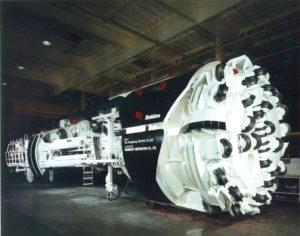 The 275 KV Cable Tunnel on Hong Kong Island provides a transmission line from a power station at nearby Lamma Island. Electricity travels through the 5.4 km (3.3 mi) long tunnel via six 275 KV cables to increase power supply to residents on the eastern side of Hong Kong Island.
The 275 KV Cable Tunnel on Hong Kong Island provides a transmission line from a power station at nearby Lamma Island. Electricity travels through the 5.4 km (3.3 mi) long tunnel via six 275 KV cables to increase power supply to residents on the eastern side of Hong Kong Island.
The Hong Kong Electric Co., owner of the project, contracted Nishimatsu Construction Co. to build the tunnel. Nishimatsu chose a 4.8 m (15.8 ft) diameter Main Beam Tunnel Boring Machine (TBM) for the project, the first ever TBM to bore in Hong Kong.
Geology
The cable tunnel passes through three mountains and beneath catch-water facilities of the Tai Tam Reservoir five times along the tunnel route. The geology consists of a granite and quartz mixture with some volcanic rocks holding hard tuffs and lavas. Hong Kong granites are considered among the world’s hardest.
TBM
Robbins equipped the high-performance TBM with thirty-two 19 inch (483 mm) disc cutters, a cutterhead thrust capacity of 10,291 kN (2,313,531 lb), and a cutterhead drive of 2,275 kW (3,050 hp). The machine’s design included adjustable side supports and hydraulic roof shields to stabilize the cutterhead and aid cutter tracking. A long boring stroke maximized boring time and kept regrips to a minimum.
Tunnel Excavation
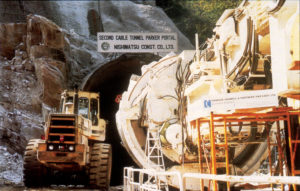 Boring on the 5.4 km (3.3 mi) long tunnel began in March 1991. The TBM advanced at a grade through granite. Initial water inflows required concrete invert section and fissure grouting to be applied along tunnel walls.
Boring on the 5.4 km (3.3 mi) long tunnel began in March 1991. The TBM advanced at a grade through granite. Initial water inflows required concrete invert section and fissure grouting to be applied along tunnel walls.
A section of the tunnel on the Wong Nei Chung fault line caused some difficulties. Shattered and weathered granites required rock support and advance probe drilling which slowed the boring process. Regardless, TBM performance remained high throughout the drive with only 55 shift hours lost to delays.
The machine broke through the tunnel in October 1991, only 53 working weeks after tunneling began. The TBM’s average advance rate was 100 m (328 ft) per week and its average rate of penetration was 2.8 m (9.1 ft) per hour.
Seymour Capilano
Project Overview
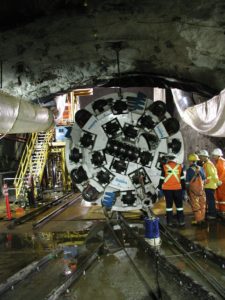 The Seymour-Capilano Water Filtration Project seeks to improve the filtration of drinking water in Vancouver, British Columbia. The completed filtration system will clean 1.8 billion liters (475.5 million gallons) of water a day and will lower the water turbidity (cloudiness) and micro-organism levels to meet federal standards for drinking water.
The Seymour-Capilano Water Filtration Project seeks to improve the filtration of drinking water in Vancouver, British Columbia. The completed filtration system will clean 1.8 billion liters (475.5 million gallons) of water a day and will lower the water turbidity (cloudiness) and micro-organism levels to meet federal standards for drinking water.
The project calls for twin tunnels, each 7.2 km (4.5 mi) long. The tunnels will transport untreated water from the Capilano reservoir to a filtration plant in the Lower Seymour Conservation Reserve and will return treated water to the Capilano reservoir for public consumption.
Geology
In 2004, the project owner, Greater Vancouver Regional District, awarded the construction contract to Germany-based Bilfinger Berger. The contractor chose two 3.8 m (12.5 ft) diameter Main Beam Robbins TBMs to bore the tunnels in intrusive granitic rock with strengths of 200 – 265 MPa (29 – 38 ksi).
TBM
Each TBM is outfitted with probe drills, to be used for the entire length of the tunnels. The probe drills probe ahead 40 m to check for pockets of underground water and verify the geology. The tunnel is unlined during excavation, but each machine is equipped with a ring beam erector to install full or partial beams depending on the geology.
Tunnel Excavation
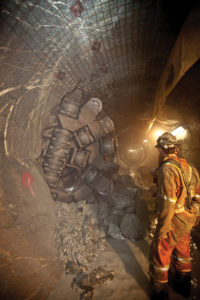 The first of the two TBMs was delivered on May 18, 2006 and began boring on July 1, 2006. The second Robbins TBM was launched from the same shaft. Both machines were assembled in very short (60.5m/200ft and 70.5 m/230 ft) starter tunnels at the bottom of the 180 m (591 ft) shaft. Because of the short tunnel lengths, both TBMs excavated with their back-up systems partially constructed until they bored ahead 200 m (650 ft). The TBMs were assembled with only 11 decks of their respective 35 deck back-up systems.
The first of the two TBMs was delivered on May 18, 2006 and began boring on July 1, 2006. The second Robbins TBM was launched from the same shaft. Both machines were assembled in very short (60.5m/200ft and 70.5 m/230 ft) starter tunnels at the bottom of the 180 m (591 ft) shaft. Because of the short tunnel lengths, both TBMs excavated with their back-up systems partially constructed until they bored ahead 200 m (650 ft). The TBMs were assembled with only 11 decks of their respective 35 deck back-up systems.
After difficult ground conditions halted both TBMs for more than a year, excavation restarted in April 2009. New contractor, Frontier-Kemper/J.F. Shea/Aecon, restarted the machines and achieved advance rates of up to 29 m (95 ft) per day.
On November 4, 2010, the final breakthrough for the second of two Robbins TBMs capped more than two years of hard rock tunneling over a four year period. Frontier-Kemper successfully dealt with rocky conditions and some faulting using a program of rock bolts, wire mesh, and steel sets. Rock support varies from bare rock in good ground (Class I), to steel sets every 760 mm (30 in) in Class V poor rock.
The second Robbins TBM holed through at an angle into the other tunnel, where a chamber will now be built to conduct raise drilling of the 270 m (885 ft) deep Capilano shaft.
San Vicente
Project Overview
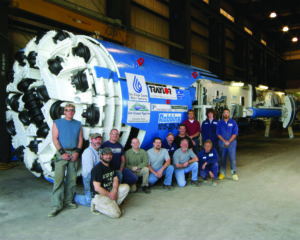 The San Vicente Pipeline, 17.7 km (11 mi) in length, connects the San Vicente Reservoir in Lakeside, California to the San Diego County Water Authority Second Aqueduct. The pipeline is part of the Water Authority’s Emergency Storage Project that will provide water to the city in the event of a drought or major earthquake.
The San Vicente Pipeline, 17.7 km (11 mi) in length, connects the San Vicente Reservoir in Lakeside, California to the San Diego County Water Authority Second Aqueduct. The pipeline is part of the Water Authority’s Emergency Storage Project that will provide water to the city in the event of a drought or major earthquake.
Project owner San Diego County Water Authority awarded the construction contract to the Traylor-Shea joint venture. The contractor chose a 3.5 m (11.5 ft) diameter Robbins Main Beam TBM and back-up system for two sections of tunnel at opposite ends, totaling about 2.75 km (1.70 mi) in length.
Geology
Due to the varying geology, multiple tunneling methods were chosen for the project. Two open-face digger shields were chosen to mine in conglomerates, while the TBM is mining in sections of rock at either end of the tunnel. The TBM-driven pass through granitic rock geology with a UCS of 140-345 MPa (2050 si).Drill and blast excavation is also being used in sections that interface the rock and conglomerate.
TBM
The refurbished TBM features 17 inch (432 mm) cutters and can generate a thrust of 6,005 kN (1,350,000 lb). The machine also has a maximum torque of 1,056,546 N-m (779,268 lb-ft) at the cutterhead. The Robbins back-up system consists of 11 decks and muck is being removed via muck cars.
Tunnel Excavation
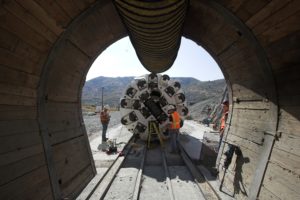 Boring began on June 21, 2006 after an onsite TBM assembly of only 30 working days. The machine excavated a 1.2 (0.7 mi) section west of the San Vicente Portal. and was then slated for an additional 400 m (1300 ft) section in weathered granite with clay seams. The Traylor-Shea JV slowed rotation of the cutterhead in order to bore through the mixed face and avoid clogging of the muck buckets. Excavation of the section using the TBM, rather than drill and blast, saved approximately 120 days on the construction schedule. The machine was then removed and re-launched at the West shaft where it will bore 1.3 km (0.8 mi) east. The machine excavated in granite requiring steel ribs and rock bolts, and completed its second section in April 2008.
Boring began on June 21, 2006 after an onsite TBM assembly of only 30 working days. The machine excavated a 1.2 (0.7 mi) section west of the San Vicente Portal. and was then slated for an additional 400 m (1300 ft) section in weathered granite with clay seams. The Traylor-Shea JV slowed rotation of the cutterhead in order to bore through the mixed face and avoid clogging of the muck buckets. Excavation of the section using the TBM, rather than drill and blast, saved approximately 120 days on the construction schedule. The machine was then removed and re-launched at the West shaft where it will bore 1.3 km (0.8 mi) east. The machine excavated in granite requiring steel ribs and rock bolts, and completed its second section in April 2008.
Plateau Creek
Project Overview
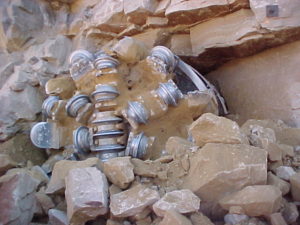 The Plateau Creek Pipeline was built to replace a pre-existing pipeline that supplied fresh water to rural and urban areas of Mesa County, Colorado, USA. The new tunnel provides water to 70,000 customers and has four times the hydraulic capacity of the old pipeline, which was unable to meet the District’s peak water demands.
The Plateau Creek Pipeline was built to replace a pre-existing pipeline that supplied fresh water to rural and urban areas of Mesa County, Colorado, USA. The new tunnel provides water to 70,000 customers and has four times the hydraulic capacity of the old pipeline, which was unable to meet the District’s peak water demands.
The project owner, UTE Water Conservancy District, awarded the construction contract for the entire 21 km (13 mi) pipeline to the Barnard-Affholder Joint Venture. Affholder was solely responsible for the two sections of tunnel that were bored by TBM. The contractor used a 3.3 m (10.8 ft) diameter Robbins Main Beam TBM to bore two tunnel lengths of 1.0 km (0.6 mi) and 3.1 km (1.9 mi).
Geology
The geology consists of sandstone, shale and siltstone with an Unconfined Compressive Strength (UCS) of 69 – 172 MPa (10 – 25 ksi). The rock required immediate support including rock bolts, wire mesh, and shotcrete.
TBM
Robbins rebuilt and modified the Affholder-owned Robbins Main Beam TBM specifically for the project. The machine had been a workhorse for Affholder, who has used the machine on nine different projects totaling over 30 km (19 mi) since purchasing the machine in 1993.
Modifications included a new cutterhead, cutterhead power increase by 25%, a new high capacity main bearing and a thrust increase to allow a loading of 267 kN (60,000 lb) per cutter. The machine was capable of up to 4,893 kN (1,100,000 lb) of cutterhead thrust and could generate up to 455,738 N-m (336,135 lb-ft) of torque at the cutterhead.
Tunnel Excavation
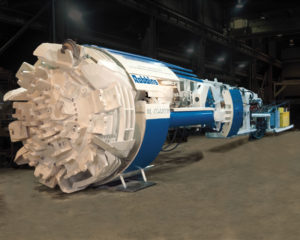 Boring began on the 1 km (0.6 mi) long tunnel in June 2000 and the machine holed through in August, just 1 month later. The machine was then disassembled and re-launched in only 2 weeks to bore the longer 3.1 km (1.9 mi) tunnel.
Boring began on the 1 km (0.6 mi) long tunnel in June 2000 and the machine holed through in August, just 1 month later. The machine was then disassembled and re-launched in only 2 weeks to bore the longer 3.1 km (1.9 mi) tunnel.
Excavation on the second tunnel began in September 2000. The machine set a world record in its size class on September 14th when it advanced 67 m (219 ft) in a single eight-hour shift. The TBM holed through ahead of schedule on March 16, 2001.
Meråker
Project Overview
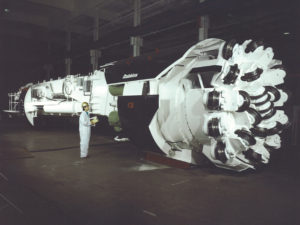 The Meråker Project consists of a system of power stations and underground tunnels that increase the electrical output supplying a local smelter and surrounding areas. Three lakes and several rivers supply 44 km (27.3 mi) of tunnels that feed into a generating facility in Tevla. From Tevla, a combined headrace/tailrace tunnel carries the water to the power station at Meråker.
The Meråker Project consists of a system of power stations and underground tunnels that increase the electrical output supplying a local smelter and surrounding areas. Three lakes and several rivers supply 44 km (27.3 mi) of tunnels that feed into a generating facility in Tevla. From Tevla, a combined headrace/tailrace tunnel carries the water to the power station at Meråker.
Merkraft, a joint venture of Eeg Henriksem Anlegg a/s and a/s Veidekke, chose a Robbins 3.5 m (11.5 ft) diameter Main Beam tunnel boring machine (TBM) to bore 10 km (6.2 mi) of tunnel at Meråker. The remaining sections of tunnel were excavated by drill and blast.
Geology
Rocks along the tunnel path consist of Cambrian and Ordovician metamorphic sediments with meta gabbro intrusions. In all, six different rock types exist along the tunnel route. These rocks include relatively soft phyllite; mixed face rocks such as greywacke and sandstone; and hard meta gabbro.
TBM
Robbins built the Main Beam TBM to successfully bore through varying rock conditions—from hard to mixed face. The machine featured four 335 kW (459 hp) motors and 25 front-loading disc cutters 19 inches (483 mm) in diameter. The TBM had cutterhead power of 1,340 kW (1,836 hp) and a maximum cutterhead thrust of 10,291 kN (2,313,531 lb).
The High-Power TBM was a stronger, more durable TBM than its predecessors. It was one of the first TBMs of a line that Robbins developed to withstand higher loads. These machines ushered in the new generation of TBMs with features such as triple axle main bearings and cutterhead modifications to improve boring efficiency at high thrust.
Tunnel Excavation
The TBM began boring at an impressive rate in September 1991. In its first full month of boring, the TBM excavated 1,029 m (3,376 ft). Soon after, the machine set a Norwegian tunneling record of 395 m (1,295 ft) during the week of October 28-November 3, 1991. During the course of the drive, the TBM reached rates of penetration up to 10 m (32.8 ft) per hour. Its average rate of penetration was 6 m (21 ft) per hour or 253 m (830 ft) per week. The machine’s best day was 100 m (329 ft), its best week was 427 m (1,400 ft), and its best month was 1,358 m (4,455 ft). The TBM accomplished these high advance rates despite Norwegian regulations limiting underground construction projects to 100 shifts per week.
In 1992 the TBM finished the 10 km (6.2 mi) tunnel six months ahead of schedule. The early completion allowed workers to finish all 44 km (27.3 mi) of tunnel in late 1992.
Tampa Bay
Project Overview
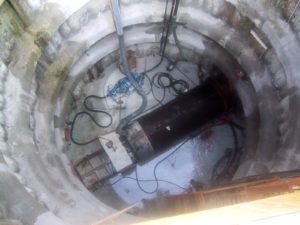 The South Central Hillsborough Intertie tunnel passes under the Alafia River in Tampa Bay. The tunnel is part of Master Water Plan Stage B, an ambitious three-stage plan to replenish Florida’s depleted groundwater.
The South Central Hillsborough Intertie tunnel passes under the Alafia River in Tampa Bay. The tunnel is part of Master Water Plan Stage B, an ambitious three-stage plan to replenish Florida’s depleted groundwater.
Tampa Bay Water, the project owner, awarded Contract 2 for the South Central Intertie to Kenko Inc. in 2002. The contractor chose an innovative new solution to deal with the difficult ground conditions of the tunnel: a Robbins hybrid EPB shield machine.
Geology
The tunnel travels though the extremely permeable, highly fractured limestone of the Floridian aquifer with over 2.5 bar of hydraulic face pressure. Above the limestone is a layer of very stiff green clay and above the clay is a 4.6 m (15 ft) thick layer of loose, silty fine sand.
EPBM
The contractor chose Robbins because they needed design parameters that encompassed hard rock TBMs, EPBMs, and slurry shields. The EPBM featured eight double and four single backloading 17 inch (432 mm) cutters. The machine was capable of 5,783 kN (1,300,000 lb) of thrust and could generate a torque of 409,457 N-m (302,000 lb-ft) at the cutterhead.
Two face ports at each side of the machine permitted drilling and grouting in difficult conditions. Excavated ground was extracted with a 17 inch (432 mm) diameter invert auger screw. The muck was then conveyed to a mixing chamber to agitate and crush the limestone. The entire excavation system was a closed and pressurized face built to withstand up to 3 bar of hydraulic pressure.
From the mixing chamber, the muck traveled to a slurry pump installed inside the tunnel. The slurry pump transported the muck in a tube to the shaft where it connected with a second pump that brought the muck to the top of the shaft. The slurry pumps directly discharged the cuttings to the surface because the limestone was too porous to form a matrix. Therefore, the sluggish characteristics of the muck made muck transport via screw auger into muck cars too difficult.
Tunnel Excavation
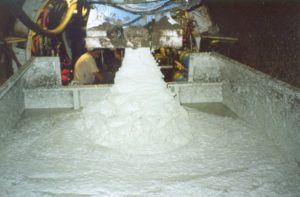 The hybrid EPBM began boring on May 27, 2002. In the early stages of tunnel excavation, the machine operated in usual EPB mode and material was removed with muck cars.
The hybrid EPBM began boring on May 27, 2002. In the early stages of tunnel excavation, the machine operated in usual EPB mode and material was removed with muck cars.
As the machine continued boring, it encountered increasing hydraulic loads of up to 2.5 bar. This anticipated condition was treated with a circular break system that kept the EPBM in place.
However, the high water pressures prevented the excavated material from forming a plug in the screw conveyor. Injection of ground conditioning additives did not improve the situation and water inflow to the tunnel continued. The mucking system was then converted from muck cars to the more efficient slurry system involving slurry pumps.
After the conversion, the EPBM progressed well and broke through on August 22, 2002 only 3 mm (1/8 in) off of target.
South Mountain
Project Overview
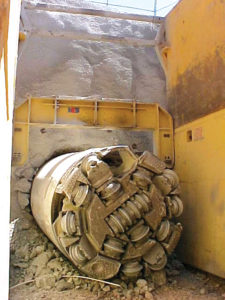 Arizona’s South Mountain water tunnel is part of a 27.3 km (17 mi) water pipeline that delivers 178 million liters (47 million gallons) of water a day to the city of Phoenix. The pipeline serves the Ahwatukee Foothills area, which has experienced 145% population growth in the last decade.
Arizona’s South Mountain water tunnel is part of a 27.3 km (17 mi) water pipeline that delivers 178 million liters (47 million gallons) of water a day to the city of Phoenix. The pipeline serves the Ahwatukee Foothills area, which has experienced 145% population growth in the last decade.
In 2000, the City of Phoenix awarded the $11 million USD construction contract to Affholder Inc. Affholder chose a refurbished Robbins Double Shield TBM adapted for the variable rock conditions in the tunnel.
Geology
The tunnel passes through three types of rock. The first and last sections of tunnel consist of the hard, coarse-grained rocks granite and gneiss. The middle of the tunnel consists of two infiltrations of alluvial soils. This soil is mixed grain and exhibits secondary calcification. Locally known as caliche, these soils can exhibit behavior similar to rock.
To address the challenge of soil deposits, tunnel design consultants recommended steel ribs with lagging for tunnel support.
TBM
Robbins rebuilt the 2.4 m (7.9 ft) diameter Double Shield TBM for the variable rock conditions in the tunnel. The TBM design included dual propulsion systems, a protective shield, recessed cutters, and the ability to reverse cutterhead direction.
The TBM featured 432 mm (17 in) cutters and a maximum thrust of 4,372 kN (1,006,000 lb). The 60 Metric ton (66 US ton) machine was capable of generating 194,172 N-m (146,000 lb-ft) of torque.
Tunnel Excavation
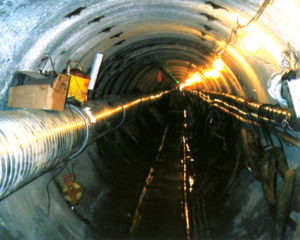 The TBM began boring the 1.85 km (1.15 mi) long tunnel in December 2000 and encountered its first soil deposits three months later. The soft soil prompted a switch from rock bolts to steel ribs and wood lagging for the tunnel lining. The machine reached the second infiltration of soil after boring through a 360 m (1,181 ft) section of gneiss. The TBM excavated the final sections of the tunnel with no problems and finished on schedule in August 2001.
The TBM began boring the 1.85 km (1.15 mi) long tunnel in December 2000 and encountered its first soil deposits three months later. The soft soil prompted a switch from rock bolts to steel ribs and wood lagging for the tunnel lining. The machine reached the second infiltration of soil after boring through a 360 m (1,181 ft) section of gneiss. The TBM excavated the final sections of the tunnel with no problems and finished on schedule in August 2001.
The crew worked in 9-hour shifts and the maximum rate of advance was 26 m (85.3 ft) in a single shift. The TBM average rate of advance was 1.5 m (4.9 ft) per hour.
Cleveland Sewer
Project Overview
The Cleveland Heights Interceptor Project is a sewer system improvement project located in the Heights/Hilltop area of Cleveland. The project is one of hundreds projects mandated by the USA Environmental Protection Agency in the wake of the Clean Water Act which required communities to improved the quality of America’s river and lake water. (For more information on the Clean Water Act and its effects, see www.epa.gov/r5water/cwa.htm).
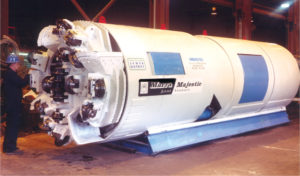 During the torrential rains of spring and summer in the Cleveland area, the water flow overcame the existing sewer system resulting in flooding and the discharge of untreated water into Lake Erie. Larger-diameter pipelines were proposed to help reduce the basement flooding and sewage overflow problems which were common in the crowded urban area.
During the torrential rains of spring and summer in the Cleveland area, the water flow overcame the existing sewer system resulting in flooding and the discharge of untreated water into Lake Erie. Larger-diameter pipelines were proposed to help reduce the basement flooding and sewage overflow problems which were common in the crowded urban area.
Geology
The TBM passed mostly through gray Berea sandstone that is fine to medium grained and significantly fractured in discrete zones. The rock has moderate to high abrasiveness as well as a potential for gas and water inflows from fissures and joints.
TBM
Robbins designed the 2.2 m (7.2 ft) diameter TBM to bore through fractured rock with potentials for water inflow. The TBM included a variable speed, hydraulic cutterhead drive and a high-capacity asymmetric main bearing. The machine also included roof and probe drills for rock support and pre-excavation ground investigations respectively. The TBM featured 12 inch (305 mm) cutters that could generate a maximum thrust of 4,472 kN (1,006,000 lb). Maximum cutterhead torque was 194,172 N-m (146,000 lb-ft). The 60-ton, gantry-style back-up system was designed to run efficiently with muck cars at maximum capacity.
Tunnel Excavation
The TBM began boring in July 1998. It experienced few problems and achieved impressive daily advance rates. Between the months of September and December 1998 the machine averaged 42 m (138 ft) per day and achieved a best day of 55 m (182 ft) bored. The machine finished in December 1998 with a monthly average of 442 m (1450 ft). Crews worked in 5-day work weeks with 2 shifts per day and the machine averaged 21 m (69 ft) per shift.
Big Sky
Project Overview
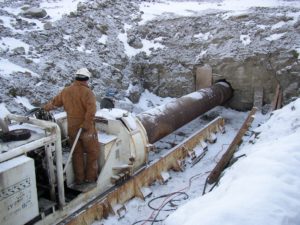 The Yellowstone Club, a private resort in Big Sky Montana, includes an 18-hole championship mountain golf course in addition to miles of ski trails. This golf course is irrigated by 318 ft (96.9 m) of pipeline from a nearby 79 million gallon reservoir.
The Yellowstone Club, a private resort in Big Sky Montana, includes an 18-hole championship mountain golf course in addition to miles of ski trails. This golf course is irrigated by 318 ft (96.9 m) of pipeline from a nearby 79 million gallon reservoir.
In 2005, the project owner contracted Tunnel Systems Inc. to bore the pipeline. The contractor started out with an Auger Boring Machine with a Christmas tree’ head attachment. However, they ran into problems 59 feet (18 m) into the dig when they began boring through hard rock. The next two days of the bore cleared only 16 feet (4.9 m). For the rest of the dig, Tunnel Systems Inc. leased a Robbins 30 in (762 mm) diameter Small Boring Unit (SBU).
Geology
The section of pipeline through hard rock contained mixed ground conditions including sections of solid rock and mixed rock with soil.
SBU
Tunnel Systems elected to utilize a Robbins SBU because they are designed for bores just like this project — in rock with an Unconfined Compressive Strength (UCS) greater than 24,000 kPa (3.5 ksi). They utilized an SBU without stabilizer feet, available on 30 in (762 mm) and 24 in (609 mm) models. Stabilizer feet are standard on all SBU models 36 in (914 mm) in diameter and above, as well as available on some 30 in (762 mm) models. The SBU featured Robbins’ patented disc cutters to obtain the highest advance rates in hard rock. The SBU’s design is based on the same technology as the large-diameter tunnel boring machines.
Tunnel Excavation
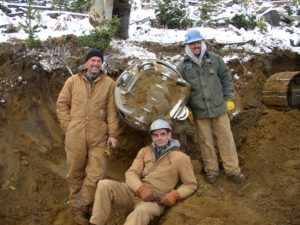 At the jobsite, the SBU was welded to the lead pipe casing. In order for the boring to begin, the SBU received thrust from the pipe casing and torque from the Auger Boring Machine (ABM). Muck was then removed through the auger.
At the jobsite, the SBU was welded to the lead pipe casing. In order for the boring to begin, the SBU received thrust from the pipe casing and torque from the Auger Boring Machine (ABM). Muck was then removed through the auger.
Upon restarting the dig, the SBU achieved impressive advance rates of 43-49 ft (13.1-14.9 m) per day. The ABM and SBU bored through solid rock for approximately 197 ft (60 m) and bored through mixed rock and soil for the final 20 ft (6 m).
The SBU finished the project on time despite some setbacks. Harsh weather conditions on the job site of 19 degrees Fahrenheit (-7 degrees Celsius) and 40 mph (65 km/h) winds made it too difficult to work and the bore was forced to halt until the snowstorm passed. The crew completed the project in just a few hours on the following day.
Recent Posts
- World Tunnel Congress 2024
- Use of a Tunnel Boring Machine on Nepal’s First and Second TBM-Driven Tunnels
- Robbins Double Shield Sets Record in Nepal
- Final Breakthrough at Bahçe-Nurdaği Railway
- Record-Setting Large Diameter Mixed Ground Tunneling in Turkey: The Eşme-Salihli Railway Tunnel

 Close
Close  Menu
Menu 